Satan's Great Counterfeit
(Part Two)
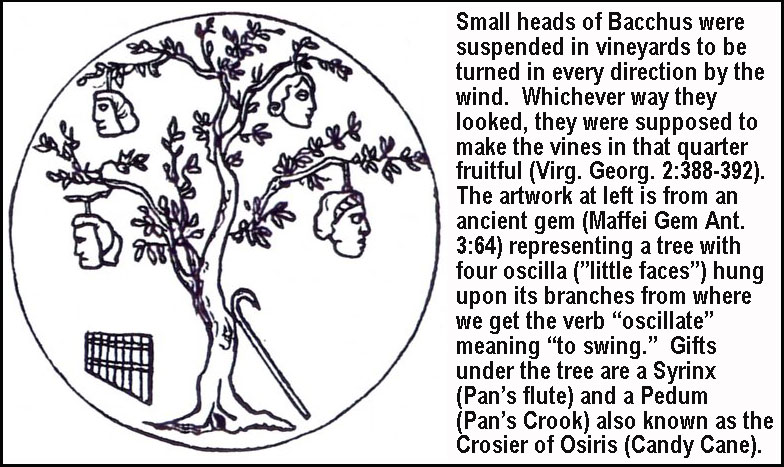
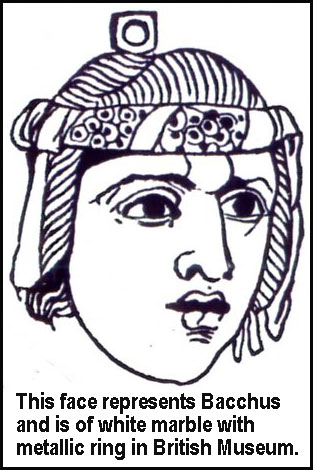
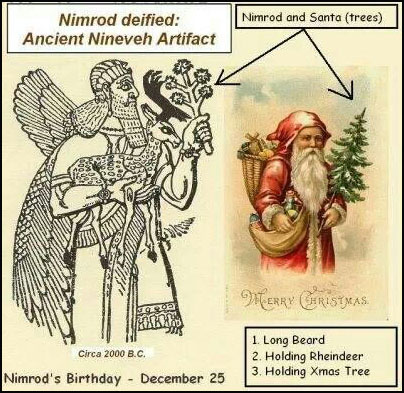
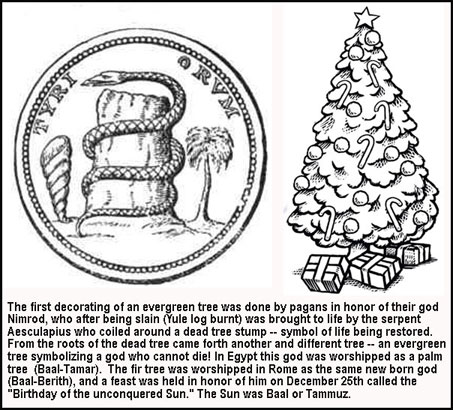
How Did Tree-Worship Originate?
After Osiris had been executed, his coffin was discovered enclosed in a TREE trunk, and he is spoken of in the inscriptions as "the one in the TREE" or "the solitary one in the ACACIA." The rites too, by which his death and burial were annually celebrated appear to couple him closely with Tammuz, Adonis, Attis, Dionysus and other gods whose worship was associated with a similar ritual. (Frazer, Golden Bough 1:307) TREE GODS die and are revived annually with vegetation. Tammuz was represented as originally dwelling in a TREE (Sayce, p.238, Religion of Ancient Babylonians). Adonis, beloved of Aphrodite, was born from a MYRRH-TREE. Attis, the favorite of Cybele, was represented in Phrygia in the form of a decorated PINE TREE, to which his image was attached. Dionysus was worshipped throughout Greece as "Dionysus of the TREE." The SIAMESE at the present day frequently make offerings to the TREE-dwelling spirits, and HANG GIFTS on any TREE whose deity they desire to propitiate (Tylor, Primitive Culture, 2:196). Druids of Britain worshipped the OAK TREE. (Pliny Natural History, 16:95). Xerxes decorated a PLANE TREE with golden ornaments in Lydia (Her. 7:31). The custom of adorning TREES "with jewels and mantles" was very ancient and universal (Aelian V.H. 2:14; Theocr. Id. 18; Ovid Met. 8:723, 745; Arnob. adv. Gentes 1:39) and even today exists. "The Saturnalia, like Christmas, was a time for giving presents. Small DOLLS were a popular gift -- though for an unpleasant reason. They commemorated a myth that Saturn ate all his male children at birth, to fulfill a pledge that he would die without heirs" (The United Church Observer, "Santa's Family Tree," Dec. 1976, p. 14). "All classes exchanged gifts, the commonest being waxed tapers and CLAY DOLLS ... These DOLLS were especially given to children. Varro thought these DOLLS represented original SACRIFICES of human beings to the infernal god" (Encyc. Brit. 24:231, 11th ed.). "When ye offer your gifts ... ye pollute yourselves with all your idols" (Ez. 20:31). The Puritan Long Parliament in April, 1644, decreed the removal of the MAYPOLE as "a heathenish vanity greatly abused to superstition and wickedness." Thus saith the Eternal, Learn not the way of the heathen ... For the customs of the people are vain; for one cutteth a TREE out of the forest, the work of the hands of the workman, with the axe. They DECK it with SILVER and with GOLD; they fasten it with nails and with hammers, that it move not. They are upright like the palm tree, but speak not" (Jer. 10:2-5). “Little children, keep yourselves from IDOLS” (1 John 5:21). “A CORRUPT TREE bringeth forth EVIL fruit” (Matt. 7:17). "Thou shalt take up this proverb against the king of Babylon ...The Lord has broken the rod of the wicked ... All the lands are at rest and at peace; they break into singing. Even the PINE TREES and the cedars of Lebanon exult over you and say, ' Now that you have been laid low, no woodsman comes to CUT US DOWN'" (Isa. 14:5-8).
Semiramis Created Mystery Religions With Pilgrimages, Relics, Shrines, Celibacy, and A False Messiah
Ancient traditions relate that Nimrod was slain in Rome by Shem and his dead body was cut into pieces as a warning not to apostasize (Wilkinson's Egyptians, vol. 5, p.17; Hislop, p.63, 232). Plutarch describes the search Semiramis made for these pieces. "Isis set out ... in search of the scattered members of her husband's body ... and one reason assigned for the different sepulchers of Osiris in Egypt is that whenever any one of his scattered limbs was discovered she buried it on the spot. Not only were these Egyptian RELICS sacred themselves, but they consecrated the very ground in which they were entombed" (Plutarch vol.2, pp.358-359). This led to PILGRIMAGES to worship RELICS and SHRINES. This ancient practice of cutting a body into pieces was even found in the Bible (Judges 19:29; 1 Sam. 11:7). Thereafter idolaters were afraid to practise their apostasy in the open. They didn't want to be executed. So they developed the "Mystery Religions" to disguise their idolatry (Hislop, p.66). Men whose "deeds are evil love darkness rather than light" (John 3:19). The story of Typhoeus relates that the gods were so frightened that they fled away to Egypt where Pan (Cush) advised them to assume the shapes of various animals to conceal their identity (Lemprierre, Typhaeus, Typhon, Pan, Gigantes; Ovid Fasti book 1, lines 393-404; Diod. Bibl. 1:16; Hyg., Poet. Astron., 2:28; Hyg. Fab. 196; Eratos., Catast., cap 27; Faber vol.2, p.406).
Semiramis had heard of the woman's prophesied seed who was to come and through whom mankind might obtain eternal life. "He shall bruise your head and you shall bruise your heel" (Gen. 3:15). This gave her a daring idea. She portrayed her dead husband, Nimrod, as the benefactor "savior" of mankind whose death would redeem mankind from eternal death. She combined his sun-serpent worship with Noah's prophecy of the Savior who would die for mankind. She claimed to "supernaturally" conceive and cause Nimrod to be reborn -- by means of one of her many illegitimate children -- called Horus. She palmed herself off as the virgin mother and made her dead husband the resurrected savior -- over 2000 years in advance. The Bible refers to the couple as "Baal and Ashtaroth" (Judges 2:13). Those who explained the meaning of the Mysteries to initiates were called "PETER" in the primitive Chaldee, the real language of the Mysteries. This means "INTERPRETER" (Parkhurst's Hebrew Lexicon, p.602). It was one of these interpreters or "PETERS," who was in pagan Rome long before Christ. He was confused with Peter the apostle of Christ. "The mystery of iniquity" continues to this day (2 Th. 2:7). Isis (Semiramis) established a priesthood, bound to secrecy and CELIBACY. The worship of Cybele, the Babylonian goddess, was introduced into pagan Rome, with its CELIBATE clergy (Pausanias 7:17:566). This was adopted by the Papal priesthood. Words with double meanings and mystic symbols and secret rites were employed to create "the Mysteries" for the purpose of resuscitating IDOLATRY while avoiding exposure. In this way, Horus finally defeated Typhon. IDOLATRY was triumphant. One body part that Semiramis was unable to find was his PHALLUS, so she made a wooden representation of it, and paid it special honor (Lemprierre, Isis, Phallion). That is where PHALLIC worship came from. There were several cities in Middle Egypt called "Busuris," meaning the burial place of Osiris (Osburn, vol.1, pp.328-329).
When Nimrod was executed, his Cushite followers fled to Ethiopia, but Saturn (Menes or Cush) fled to Italy (Lempriere, Saturn), and not only do the ruins of the two cities, Saturnia and Janicula, mentioned by Virgil (Aeneid, book 8:2 467-470, vol.3. p.608) attest to the fact, but Latium is also said to have received its name from
"latere," "to lie hid," because Saturn was supposed to be hidden there (Ovid Fasti book 7, l.238, vol.3. p.29; Aeneid, book 8, l.319, etc., p.384). Latinus, or Lateinos, the ancient king of Italy and father of the Latins, may have been Saturn. For Saturn signifies "the hidden one," and this also is the meaning of "Latinus," which is evidently derived from "Latere," which is itself derived from the Chaldee "Lat," "the hidden one" (Hislop, p.270, note). Aeneas represents Latinus to be the grandson of Saturn (Aeneid book 7:45-49; Hislop, p. 271 note), but this may be only to make a distinction between god and man. Latinus was also deified as a son of the Sun god (Dryden, Virgil book 12:245,248, vol.3, p.775). This fact together with the fact that Saturn, Latinus and Latium have all the same meaning and that Italy was formerly called "The Saturnian Land," seems to indicate that the ancient Latins were a Cushite colony founded by Cush. The most ancient people of Italy were called Etrurians and were of Accadian or Cushite origin which tends to confirm this.
The complete defeat of Semiramis by the king of India and the destruction of her army prevented any assistance from Babylon (Lenormant, Ancient Hist. of the East 1:364, 367). But she represented Nimrod's death as voluntarily suffered for the good of mankind, and that he was none other than the "promised seed of the woman" -- the messiah -- the redeemer -- who destroyed the serpent but suffered death. Therefore Nimrod was called Zoroaster (Zero [seed] + ashta [fire or woman]) whom Suidas says was the founder of Babylonian idolatry (Suidas 1:1133; Hislop, p.59 note). Both the "seed of the woman" and "fire god." "Osiris" may mean "The seed" also (Wilkinson's Egyptians 4:103, note) and therefore Typhon (Shem) was portrayed as the evil serpent. Nimrod is then reincarnated as Horus, Apollo or Chrishna to slay the "serpent" Typhon, Pytho or Calyia.
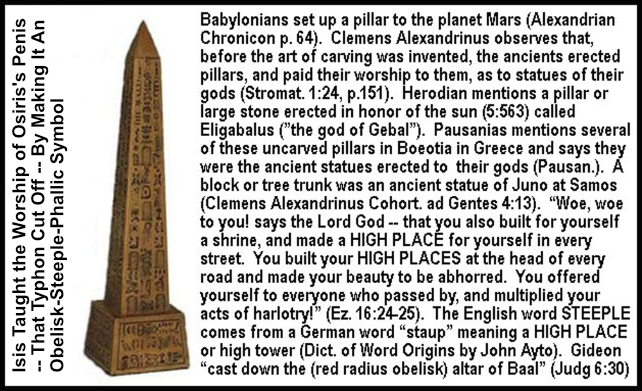
.jpg)
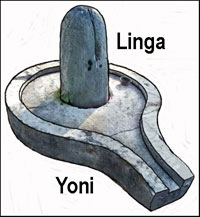
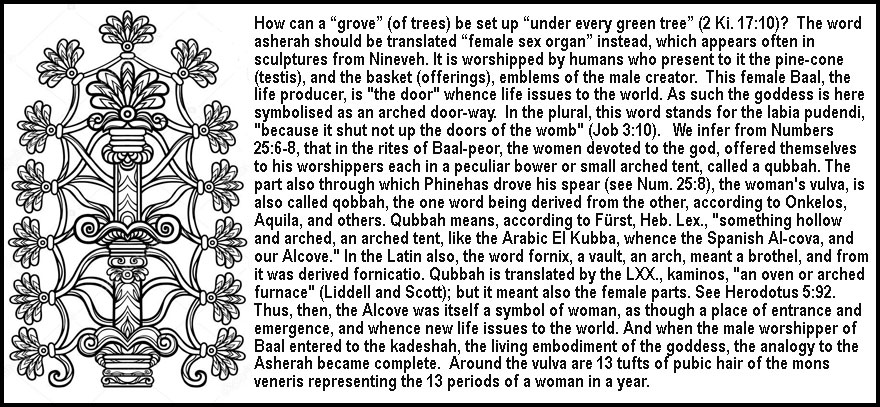
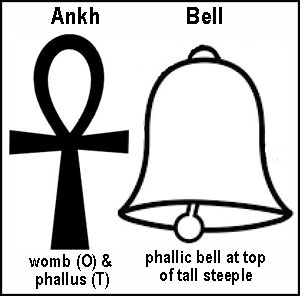
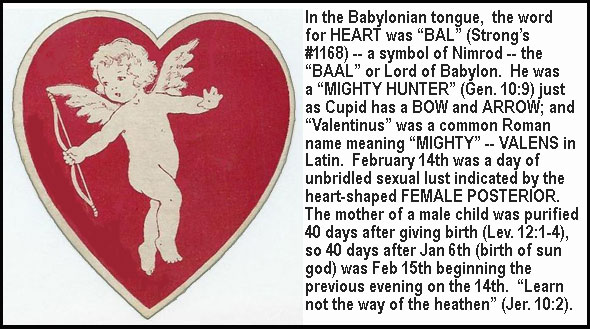
![]qpd](israel/Priapus-worship.jpg)
Semiramis Taught Sacred Orgies, Prostitution and Phallic Worship
Herodotus claimed all Babylonian women were required to PROSTITUTE themselves once in their life for religious purposes (Hist. 1:199). In ancient Greece, sacred PROSTITUTION was known in the city of Corinth where the Temple of Aphrodite employed a significant number of female servants (Strabo Geographica 8:6:20). Sacred PROSTITUTION was common in Egypt, Greece, Phoenicia, India and Babylon in ancient times. All young virgins, says Strabo, were prostituted in the temples of Persia; and the Armenian virgins in the temple of Anaitis. The Babylonian females were obliged to prostitute themselves in Mylitta's temple to any stranger who chose it (see Baruch 6:40) Lucian shows that at Biblus women were prostituted in the temple of Venus. (Dea Syria) Valerius Maximus says the same as to Carthage. Also in Numidia at Sicca Venerea. Justin tells us the virgins of Cyprus were prostituted in the temple of the Babylonian Belus; and in Jove's at Egyptian Thebes, a woman was enjoyed nightly. (Herodotus 1:182; 2:51). Micah 1:7 condemns "the hire of an HARLOT". Fertility rites, sexual orgies, eunuchs and priests wearing female attire, maypoles, obelisks, bells, round towers, lingam (phallus) and yoni (vagina) can all be traced back to Babylon since Semiramis was unable to find Nimrod's PHALLUS, so she made a wooden representation of it, and paid it special honor (Lemprierre, Isis, Phallion). That is where PHALLIC worship came from. Osiris was the PHALLIC god, and at his SHAMELESS and OBSCENE festivals huge figures of the PHALLUS were carried in procession (Herodotus 2:48-49). Osiris was also known as PRIAPUS (p. 88 Sanchoniathon). Plutarch says that the festival of Pammylia in honor of Osiris resembled the Phallophoria, or PHALLIC festival in Greece, and adds that "from the manner of celebrating it, it is evident that Osiris is in reality the great principle of FECUNDITY" (Plutarch, De Iside S. 12, s. 36; Wilkinson 3:83). Valentine's Day is a modern continuation of this tradition.
It is true that Abraham erected PILLARS (Gen. 21:33: "grove" Heb. eshel -- tamarisk) and Jacob set a STONE "up for a PILLAR, and poured oil upon the top of it" (Gen. 28:18). But what Moses condemned was the PILLAR worship of foreign gods (Deut. 12:1-4: "grove" Heb. asherah -- shrine) since Yahweh likens himself to a STONE or PILLAR (Ex. 13:21; Deut. 32:18,37; Josh. 24:26; 2 Sam. 22:32; Ps. 18:2; Ps. 92:15; Ps. 95:1). Asa destroyed an idol in a "GROVE" (1 Ki. 15:13). Baal, says Inman, means "My Lord the OPENER " and Peor signifies "the OPENING of the maiden's HYMEN" (Thomas Inman, Ancient Faiths, 1:325). Thus Baal-Peor claimed from man the sacrifice of circumcision and from woman the sacrifice of her MAIDENHEAD. The name Baal-Peor, says Iarchi, was given to the god because his followers "distended their POSTERIORS before him and offered to him the deposit"; while the female worshippers of the idol uncovered the MONS VENERIS before it. In Syria, says St. Jerome, the image of Baal-Peor had a PHALLUS protruding from its mouth. The Hebrews viewed this deity as obscene, filthy and abominable. As Hosea said, "They went to Baal-Peor, and separated themselves (STRADDLED) unto that shame; and their abominations were according as they loved." "The adoration", says Maimonides, "made to this idol called Pehor, consisted of discovering the SECRET PARTS before it. The law therefore commanded the priests to WEAR DRAWERS when they sacrificed, and forbade them to get up to the altar by steps, lest their NAKEDNESS should happen to be uncovered." (Thomas Lewis, Origines Hebraeae 5:71). Yet the reality is that "God remembered Rachel, and God hearkened to her, and OPENED her womb." He is the real OPENER.
It was the universal custom for anyone making a vow to place his hand upon either his own SEXUAL MEMBER or upon that of the other person concerned. Apparently the PENIS represented Yahweh. "Put, I pray thee, thy hand under my thigh (on my CIRCUMCISED PENIS): and I will make thee swear by the Lord, the God of heaven, and the God of earth" (Gen. 24:2; 47:29).
Also "We have given the hand to the Egyptians, and to the Assyrians, to get enough bread to eat" (Lam. 5:6). God himself reviles Pharaoh for breaking the covenant when "he had given his hand" (Ez. 17:18) and when Solomon was made king of Israel, "all the princes, and the mighty men, and all the sons likewise of King David, submitted themselves unto Solomon the king" (1 Chr. 29:24). This is a euphemism for the literal Hebrew which reads, "gave the hand under Solomon."
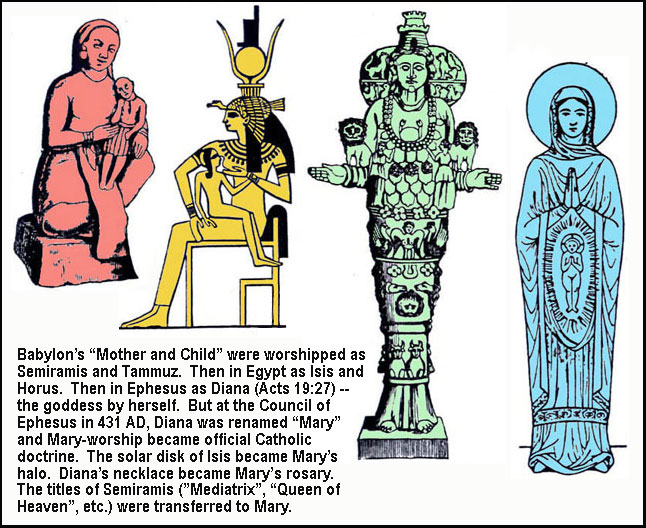
Semiramis Counterfeited the Virgin Mother
Semiramis was first the wife of Oannes, king of Syria (Assyria), who was Cush, the story being in exact accordance with the Grecian myth of Vulcan (Cush), Venus (Semiramis) and Mars (Nimrod). (see Lempriere Vulcan, Mars, etc.) Nimrod had many titles as did his wife also (Wilkinson, vol.4, p.179). The images of Semiramis and Nimrod were worshipped and adored as Madonna and Child (Isis and Osiris). The Egyptians imagined that there were two chief gods, the Sun and the Moon, called Osiris and Isis (Diodorus 1:11). Macrobius calls Osiris the Sun and Isis the Earth or Nature (Macrobius, Saturn 1:26). Plutarch says that Osiris represented "Masculine nature, or the prime cause (creative power of Sun), and that Isis represented the Earth "the feminine part of nature, the second cause or the receptive power" (Plutarch, De Iside S. 38, S. 56). In Babylon, Baal and Beltis meant "My Lord" and "My Lady". In Latin, "My Lady" is "Mea Domina" which is "Madonna" in Italian. "Alma Mater" means the "Virgin Mother." Both Justin and Castor state that Ninus was the second king of Babylon and the son and successor of Belus, and that, after the death of Ninus, his wife Semiramis succeeded him on the throne of Babylon (Justin Historia, p.615; Castor Cory's Fragments, p.65). This is also testified to by Eusebius and Africanus in their dynasties of Assyrian kings (Cory, pp.70-71).
According to Ovid and Justin, it was Semiramis who surrounded Babylon with a wall (Ovid Opera Metam. book 4. fab. 4.1.58, vol.2. p.177; Hislop p.308). Megasthenes says it was Belus who built the wall (Cory, pp.45-46). She finished what Nimrod started. Thus Rhea, known also as Cybele, is represented with a turreted crown, and Ovid says that the reason why she wore this crown was because "she was the first who erected towers in cities" (Ovid op. vol. 3; Fasti 4. 219-221; Hislop p.30) which further identifies her with Semiramis. Diana or Artemis is is also represented with a turreted crown (Hislop. p.29). Astarte actually means "Woman turret" in Hebrew.
Alexander the Great found the name of Semiramis inscribed on the frontiers of Scythia with the inscription: "I ruled the Empire of Ninus, which reaches eastward to the River Hinaman (Indus), southward to the land of incense and myrrh (Arabia), northward to the Saces and Sogdians. Before me no Assyrian had seen a sea; I have seen four that no one had approached, so far were they distant. I compelled the rivers to run where I wished and directed them to places where they were required. I made barren lands fertile by watering them with my rivers. I built impregnable fortresses. With iron tools I made roads across impassable rocks. I opened roads for my chariots where the very wild beasts had been unable to pass. In the midst of these occupations I have found time for pleasure and love " (recorded by Polyenus, Lenormant 1:367). It is well known that Semiramis was famous for her beauty and immorality, and was a fitting original for the goddess "Venus Aphrodite." The history concludes by saying that Semiramis abdicated in favor of her son, and disappeared, being changed into a dove (the symbol of Juno), and was worshipped as a goddess.
These accounts are confirmed by Strabo, who says that Ninus built Nineveh, which he describes as much larger than Babylon, and that Semiramis built the latter city. "These sovereigns were masters of Asia. Many other works of Semiramis besides those at Babylon are extant in almost every part of the continent, as, for example, artificial mounds which are called the mounds of Semiramis, and walls and fortresses with subterranean passages, cisterns for water, roads to facilitate the ascent of mountains, canals communicating with rivers and lakes, roads and bridges" (Strabo vol.3. book 16. ch. 2-3).
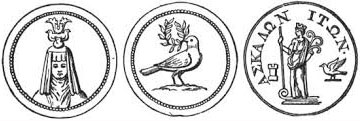
The Bible doesn't mention SEMIRAMIS by name. But in Acts we read that "all Asia and the world worships" DIANA (Acts 19:27) -- under a variety of names. DIUNE is the Chaldee for "DOVE" (Hislop, pp.78-79). DOVES were sacred to JUNO; and in a medal given by Layard (Nineveh and Babylon, p.250), the Babylonian goddess is represented with two DOVES on her head, while on the reverse there is a DOVE bearing an olive BRANCH in its mouth. Now the name "SEMIRAMIS" signifies "the BRANCH bearer": Se (the) + emir (branch) + amit (bearer). On another medal or coin (Bryant, 3:84), the goddess CYBELE, or RHEA, is represented with a conventional BRANCH in her hand and DOVE by her side. According to Hesychius, Semiramis was the name given by the Greeks to wild PIGEONS or DOVES (Hesychius, Semiramis). Diodorus Siculus and Athenagoras both say that Semiramis after her death was worshipped by the Babylonians and throughout the East as "RHEA," "the great goddess mother" (Diodorus Siculus book 2, p.76; Athenagoras, Legatio, pp.178-179; Pascal Chronicle, vol.1, p.65). She was also known in Greece as "AMMAS" which is the Hellenic form of the Chaldee AMA, "the mother." Rawlinson, speaking of the Great Goddess Mother, says, "She was ASTARTE in Phoenicia who is even said by Sanchoniathon to have had a cow's head, like Athor, the VENUS of Egypt, whence called ASHTORETH KARNAIM (Horned). She was VENUS URANIA, said by Pausanias to have been chiefly honoured by the Assyrians." He also identifies her with "ANAITIS, with CERES, with the QUEEN of HEAVEN, the MOON, RHEA, or CYBELE, JUNA, DIANA, LUCINA, ISIS, and ATHOR, the Phoenician TANITH, MINERVA and the Egyptian NEITH" (Rawlinson's Herod. vol.2, essay 1. pp.537-539). The Bible also mentions the "QUEEN of HEAVEN" (Jer. 7:18). Furthermore, the women of Judah offered "cakes (or Hot Cross Buns) to the QUEEN of HEAVEN " (Jer. 44:19). "The Greeks offered such sacred cakes to ASTARTE ... (which) they called bous (ox), in allusion to the ox-symbol marked on it, and from the accusative boun it is suggested that the word 'bun' is derived" (Encyc. Brit. 4:796). Therefore ASTARTE was the "QUEEN of HEAVEN." ASTARTE was the wife of BACCHUS and "The rites of OSIRIS and BACCHUS are the same" (Herodotus 2:42; Diodorus Siculus Bibliotheca 1:9). If BACCHUS and OSIRIS are the same, then ASTARTE and ISIS, their wives, are the same. This is confirmed when we learn that ISIS, the wife of Osiris, was also known as "the QUEEN of HEAVEN" (Lucius Apuleius The Golden Ass, book 11 ch.47). Thus BACCHUS and OSIRIS were names for Nimrod, and ASTARTE and ISIS were names for SEMIRAMIS. Furthermore, the lamentations for TAMMUZ (Ez. 8:14) during lent were the same as those for ADONIS and OSIRIS (Lucian De DeaSyria, vol.3, p.454; Bunsen vol.1p.443). That means that their wives -- ISHTAR, APHRODITE and ISIS -- were all names for Semiramis. According to Sanchoniathon, CERES is ISIS who is also PERSEPHONE (p. 206, Sanchoniathon). The pagan goddess of Egypt and Babylon was called "Dea Myrionymus" meaning "the goddess with ten thousand names".
"Semiramis, that ancient queen who was the first person to CASTRATE male youths of tender age" (Ammianus Marcellinus book 14). Her beauty is said to have once quelled a rising rebellion among her subjects on her sudden appearance among them (Valerius Maximus 9:3, p.2).
The Book of Revelation is a mirror image of Genesis. Therefore when we read about "the great whore" with "a golden cup in her hand" who commits "fornication" with "the kings of the earth" and has made them "drunk" with intoxicating false doctrine and who has a name "Mystery Babylon the Great, the Mother of Harlots and Abominations of the earth" (Rev. 17:1-5), we think immediately of Naamah and Semiramis. Semiramis was the mother of harlots because "The foulest Babylonian custom is that which compels every woman of the land to sit in the temple of Aphrodite and have intercourse with some stranger at least once in her life" (Herodotus Histories 1:199). Her golden cup is defined as "Babylon" which "hath been a golden cup in the Lord's hand, that made all the earth drunk" (Jer. 50:1). What is this "mystery of iniquity" (2 Th. 2:7)? The kings in Nimrod's day supported the counterfeit religious Mysteries of Semiramis (Rev. 17:5) -- a mixture of Noah's teaching combined with Nimrod's sun-serpent worship. The object of these Mysteries was "to bind all mankind into BLIND and absolute SUBMISSION to a hierarchy entirely dependent on the sovereigns of Babylon" (Hislop, p.5). "Cursed is the man who trusts in man, and makes flesh his arm, and whose heart departs from the Lord" (Jer. 17:5). Just as Semiramis demanded obedience from the kings who fornicated with her around 2000 BC, so also the Roman Catholic Church requires SUBMISSION from civil powers today. Semiramis pretended to be a virgin who miraculously conceived and brought forth a savior. She used an illegitimate son for this purpose. Other names for Semiramis include Astarte (Syrian) or Cybele (Roman) or Isis (Egyptian). She also bore the name "Mylitta" (Mediatrix), but Scripture says "there is one mediator between God and men, the man Christ Jesus" (1 Tim. 2:5).
From Babylon to Egypt to Greece
The similar religious rites and beliefs of of different nations so widely separated from eachother indicates "they must have all sprung from some COMMON ORIGIN" (Faber's Origin of Pagan Idolatry 1:59). "The rites of (Egyptian) Osiris and (Greek) Bacchus are the same: those of (Egyptian) Isis and (Greek) Ceres exactly resemble eachother EXCEPT IN NAME" (Diodor. 1:96; cp. Herodotus 2:42). Josephus says Abraham told the Egyptians about "arithmetic, and delivered to them the science of astronomy; for before Abram came into Egypt, they were unacquainted with those parts of learning; for that science came from the CHALDEANS into EGYPT, and from thence to the GREEKS also" (Ant. 1:8:2). This is also confirmed by Scripture, which likens the effect of the idolatry to drunkenness, and states: "Babylon hath been a golden cup in the hand of the Lord to make all the earth drunken. The nations have drunken of her wine, therefore are the nations mad" (Jer. 51:7). Zonares writes, "It is said that these (arithmetic and astronomy) came from the CHALDEES to the EGYPTIANS and thence to the GREEKS" (1:6:34). Bunsen concludes that "the religious system of EGYPT was derived from Asia and the primitive ermpire in BABEL." (Bunsen's Egypt 1:444). Layard also says, "Of the great antiquity of this primitive worship, there is abundant evidence ... having preceded that of EGYPT. The identity of many of the ASSYRIAN doctrines with those of EGYPT is alluded to by Porphyry and Clemens" (Layard's Nineveh and It's Remains, 2:440). Birch says concerning the Babylonian inscriptions: "The Zodiacal signs show unequivocally that the GREEKS derived their notions and arrangements of the Zodiac, and consequently their mythology, which was intertwined with it, from the CHALDEES." (Layard's Nineveh, 2:439, 440). Ouwaroff says that "the EGYPTIANS claimed the honour of having transmitted to the GREEKS the first elements of Polytheism" (Ouwaroff's Eleusinian Mysteries, sect. 2, p.20). Herodotus also says that the names of almost all the gods came from EGYPT to GREECE (Herodotus Hist. 2:50). Professor Rawlinson remarks, "In the Pantheons of GREECE and ROME and in that of CHALDEA the same general grouping is to be recognized; the same geneological succession is not unfrequently to be traced; and in some cases even the familiar names and titles of classical divinities admit of the most curious illustration and explanation from CHALDEAN sources. We can scarcely doubt but that, in some way or other, there was a communication of beliefs, -- a passage in very early times from the shores of the Persian Gulf to lands washed by the Mediterranean, of mythological notions and ideas" (Rawlinson's Five Great Monarchies 1:7:111-112). Yes, "it was from the East ... that GREECE derived her architecture, her sculpture, her science, her philosophy, her mathematical knowledge -- in a word, her intellectual life." (Rawlinson's "Ancient Monarchies," 3:76).
Counterfeit "Christianiy" Before Christ
At the time of Jesus, there were temples dedicated to gods like Apollo or Dionysus among the Greeks. Hercules among the Romans. Mithra among the Persians. Adonis and Attisin Syria and Phrygia. Osiris, Isis and Horus in Egypt. Baal and Astarte among the Babylonians and Carthaginians. Notwithstanding great distances, and racial differences, their CREEDS and CEREMONIES were IDENTICAL. (See Forerunners and Rivals of Christianity by Legge; Bible Myths and Their Parallels in Other Religions by Doane; Pagan Christs by Robertson and The World's Sixteen Crucified Saviors by Graves)
1. They were all born on or very near December 25 (winter solstice).
2. They were all born of a Virgin-Mother.
3. In a cave or stable.
4. They led a life of suffering for mankind.
5. They were labelled "Light-bringer," "Healer," "Mediator," "Savior," "Messiah," "Redeemer," "Lord," and "Deliverer."
6. They were "crucified for the sins of the world" or defeated by the powers of darkness.
7. They descended into Hell.
8. After being slain, they rose again from the dead after three days and ascended into heaven at Easter (Ishtar).
9. They founded churches into which disciples were received by baptism.
10. They were commemorated by eucharistic meals -- of literal flesh and blood (cannibalism).
11. Many of these savior-gods were believed to have a second coming.
There have been many counterfeit "Saviors". Many other Madonnas with child and many other crosses long before the New Testament account took place. "The SIMILARITY of ancient pagan legends and beliefs with Christian traditions was so great that they excited the attention and undisguised wrath of the early Christian ... not knowing how to explain it, they fell back to the theory the devil, centuries before, caused the pagans to adopt certain beliefs and practices." (Edward Carpenter's Pagan & Christian Creeds, p.25). Tertullian (160-220 AD) said, "The devil, by the mysteries of his idols, IMITATES even the main part of the divine mysteries." "Cortez, too, complained that the devil had possibly taught the Mexicans the SAME THING that God taught Christendom." "The Christian Church has kept itself severely apart from discussions of heathenism ... few people nowadays realize that it has sprung from just the SAME ROOT as paganism and that it SHARES by far the most part of its doctrines and rites with the latter" (pp. 11-12). Paul warned in 2 Thess. 2:7, "The mystery of iniquity doth already work."
What is Babylon?
Revelation 14:8 speaks of a BABYLON which will be destroyed in our day. Revelation 18:4 tells us to come out of BABYLON lest we receive of her plagues today. Nobody will receive eternal life while they are in this modern BABYLONIAN system. But what is BABYLON? BABYLON can be summarized as deciding for yourself what is good and what is evil -- and breaking God's law in the process. Since only God has the right to decide right from wrong, it is becoming "as gods" (Gen. 3:4-5) and self-deification to decide for ourselves. Do we presume to take God's prerogative? "Every man did that which was right in HIS OWN eyes" (Judges 21:25) -- instead of obeying the Bible. Humans counterfeited God's laws with their own laws that take the place of God's laws. BABYLON was the source from which all idolatry flowed (Herodotus History 2:109). Isaiah 47:1 describes the system which rules the earth today as the DAUGHTER of the original BABYLON and Revelation 18:3 says all nations have drunk of the wine of her spiritual fornication or false doctrine. "In vain do they worship me, teaching for doctrines the commandments of men" (Matt. 15:9). "There is a way that seems right unto a man, but the end thereof are the ways of death" (Pr. 14:12). Notice that CASTRATION and CANNIBALISM, HUMAN SACRIFICE, PHALLIC WORSHIP and SERPENT-SUN-IDOL WORSHIP are just some of the fruits of this way.
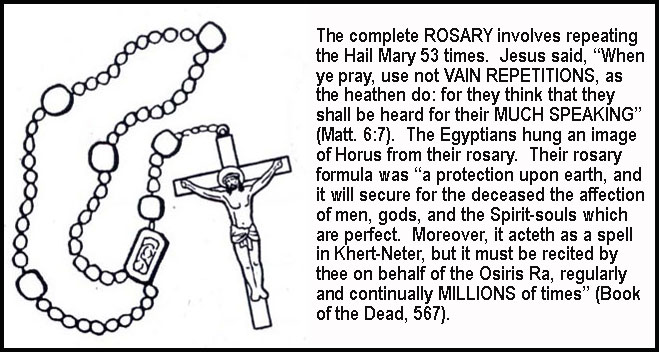
Vain Repetitions in Prayer By Using a Rosary
Jesus said, "When you pray, use not vain repetitions as the heathen do" (Matt. 6:7). Yet the Rosary -- a necklace of beads to count prayers -- was used as a sacred instrument among the ancient Mexicans (Humboldt's Mexican Researches, vol.2, p.29) and also among the Brahmins. Hindoo sacred books refer to it often. The Rosary was used by the heathen of ancient Tibet, China, Greece and ancient Rome (before the time of Christ). The name "Rosary" itself seems to be from the Chaldee (Babylonian) "Ro" (thought) and "Shareh" (director) (Hislop, p.188) indicating that it came from Babylon. Prayer must be from the heart.
Penance
At the feast of Isis at Busiris, after the ceremonies of sacrifice, many thousands of EGYPTIANS assembled and SCOURGED themselves (Her. 2:61). Callimachus spoke of sailors who visited the GREEK shrine of Apollo by saying, "Nor do the crew presume to quit thy sacred limits till they have passed a fearful penance, with the galling WHIP LASHED thrice around thine altar" (Callimachus v. 318-321, vol. 1. p.137). Similarly, in ISRAEL the priests of Baal, to appease their god, "cried aloud and CUT themselves after their manner with knives and with lancets until the blood gushed out" (1 Ki. 18:28). The Corybantes, or priests of Cybele, the priests of Bellona, and the Balluses in their nightly processions also SCOURGED themselves" (Lactantius, lib. i. cap. ii. p. 52; Hurd's Rites and Ceremonies 3:251). Speaking of the penances done by "Fakirs" of INDIA, Nightingale says, "some vow to continue for life in one unvaried posture, others undertake to carry a cumbrous load, or drag a heavy chain, some crawl on their hands and knees for years, some swing during their whole life in this torrid clime before a slow fire, others suspend themselves with their heads down for a certain time over the fiercest flames. They imagine that the expiation of their own sins and sometimes those of others consists in the most rigorous PENANCES and mortifications" (Nightingale, Religions and Ceremonies, ch. 10, p.398). In pagan ROME, Juvenal, describing a woman seeking to expiate her sins, says, "She will break the ice and go down into the river in the depth of winter; she will dip herself three times in the Tiber and bathe her timid head in its very eddies, then naked and shivering she will go and crawl on bleeding knees over the whole extent of the Campus Martius" (Satires 6:522-526). So also Tibullus says, "I would not hesitate, if I had done wrong, to prostrate myself in the temples, and to give kisses to the consecrated floors and thresholds. I would not refuse to crawl over the floor on my knees and to BEAT my wretched head against the holy door posts" (Tibullus 1:2:83).
Confessional
Initiation into the Greater Mysteries was preceded by fasting and by CONFESSION to the priest, making the initiate subject to the priest. "All the Greeks from Delphi to Thermopylae, were initiated into the mysteries of the temple at Delphi. Their silence in regard to everything they were commanded to keep secret was secured, both by the penalties threatened to a perjured revelation, and by the general CONFESSION exacted of aspirants before initiation, a confession which caused them greater dread of the indiscretion of the priest, than gave him reason to fear their indiscretion" (Eusebe Salverte, Des Sciences Occultes, ch. 26, p. 428; Hislop p. 9).
Paganism Infiltrated the Church
How did the perversion of the gospel come about? "The jewish converts who laid the foundations of the church, soon found themselves overwhelmed by the increasing multitudes that from all the various religions of polytheism enlisted under the banner of Christ" (Gibbon, vol. 1, ch. 15). Professing Christians "found a new occupation in the government of the church.... The ambition of raising themselves or their friends to offices of the church was disguised by ... laudable intention" (Gibbon vol.1, ch.15). Faithful members were ex-communicated. "Worship, at first very simple, was developed into elaborate, stately, imposing ceremonies having all the outward splendor that belonged to heathen temples.... The Imperial church of the 4th and 5th centuries had become an entirely different institution from the persecuted church of the first three centuries. In its ambition to rule it lost and forgot the spirit of Christ" (Halley's Handbook, p.671). "If, in the beginning of the fifth century, Tertullian or Lactantius (early Catholics) had been suddenly raised from the dead, to assist at the festival of some popular saint or martyr, they would have gazed with astonishment and indignation on the profane spectacle which had succeeded to the pure and spiritual worship of a Christian congregation" (Gibbon, vol.5, ch.27). "In exact proportion as paganism has disappeared from without the church, in the very same proportion it appears within it" (Geisler's Ecclesiastical History vol.2, p.40,45).
In the Millenium, "He will destroy ... the face of the (HEATHEN) COVERING cast over all people, and the VEIL (of PAGAN IGNORANCE) that is spread over all nations (Isa. 25:7). The "nations shall come unto thee from the ends of the earth, and shall say, Surely our fathers have INHERITED LIES, VANITY, and things in which there is NO PROFIT" (Jer. 16:19). Any nation which "loves and practices a LIE" will be kept out of New Jerusalem (Rev. 22:15).